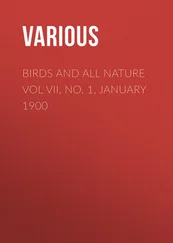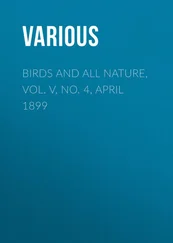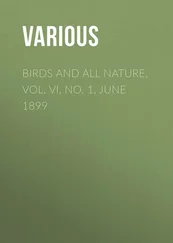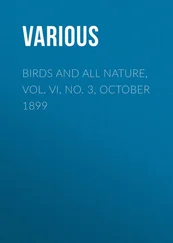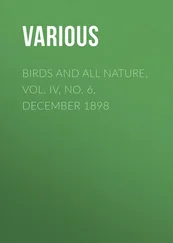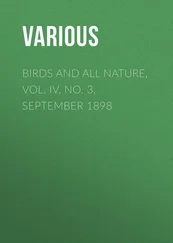Various - Birds and All Nature, Vol. V, No. 3, March 1899
Здесь есть возможность читать онлайн «Various - Birds and All Nature, Vol. V, No. 3, March 1899» — ознакомительный отрывок электронной книги совершенно бесплатно, а после прочтения отрывка купить полную версию. В некоторых случаях можно слушать аудио, скачать через торрент в формате fb2 и присутствует краткое содержание. Жанр: periodic, Биология, Природа и животные, foreign_edu, на английском языке. Описание произведения, (предисловие) а так же отзывы посетителей доступны на портале библиотеки ЛибКат.
- Название:Birds and All Nature, Vol. V, No. 3, March 1899
- Автор:
- Жанр:
- Год:неизвестен
- ISBN:нет данных
- Рейтинг книги:5 / 5. Голосов: 1
-
Избранное:Добавить в избранное
- Отзывы:
-
Ваша оценка:
- 100
- 1
- 2
- 3
- 4
- 5
Birds and All Nature, Vol. V, No. 3, March 1899: краткое содержание, описание и аннотация
Предлагаем к чтению аннотацию, описание, краткое содержание или предисловие (зависит от того, что написал сам автор книги «Birds and All Nature, Vol. V, No. 3, March 1899»). Если вы не нашли необходимую информацию о книге — напишите в комментариях, мы постараемся отыскать её.
Birds and All Nature, Vol. V, No. 3, March 1899 — читать онлайн ознакомительный отрывок
Ниже представлен текст книги, разбитый по страницам. Система сохранения места последней прочитанной страницы, позволяет с удобством читать онлайн бесплатно книгу «Birds and All Nature, Vol. V, No. 3, March 1899», без необходимости каждый раз заново искать на чём Вы остановились. Поставьте закладку, и сможете в любой момент перейти на страницу, на которой закончили чтение.
Интервал:
Закладка:
The methods of pursuit and capture of these animals are numerous, but the most common and successful are trailing in the snow with dogs, hounding, and coursing. To trail hares in the winter one must have dogs of keen scent and a light fall of from two to four inches of snow must have been deposited the night previous to an early morning start. Two or more hunters equipped with dogs and guns usually start together. Thickets of elder and blackberry are sought where the game is known to lie. The hunters skirt the border of a patch of these bushes and the dogs are sent in. The dogs soon drive the hares from cover when they become a ready mark for the gunners. Where the ground is rocky they will try to hide by running into any hole or crevice which may offer protection. In hounding hares the hunters are stationed at various points on the paths as the hares, like deer and foxes, follow regular beaten tracks. The hounds start the game from belts of pine, cedar, or hemlock. Each hunter waits for the animals to pass his station and fires at them as they go by at full run. It is considered no mean accomplishment to secure a hare under these circumstances. Trapping and snaring are also methods of capturing jack rabbits. They are principally employed by pot hunters, and many people make it their sole business during the winter months. Greyhounds are used in coursing hares, but the jack rabbit frequently discomfits both horse and hound. Hares do not live in burrows, as is the case with the rabbit, but lie in a form in bush or thicket, a slight depression in the ground serving for a nest, or sometimes a hollow stump, or the under side of a ledge of rock is selected. The young, when born, are covered with hair, their eyes are open, and they are able almost immediately to support themselves. The rabbit, on the other hand, is born with closed eyes, and requires the constant attention of the mother for some time. The hares are not so prolific as the rabbits, the female bringing forth but from three to five young at a litter, the rabbits bearing from five to eight.
Hares generally feed at night, lying in their forms in some bush or copse during the greater part of the day; rabbits, on the contrary, generally remain in the warmest corner of the burrow during the dark hours. The food of the hare consists of all kinds of vegetables similar in nature to cabbage and turnips, which are favorite dainties with it; it is also especially fond of lettuce and parsley.
The great speed of the hare in running is chiefly due to the fact that the hind legs are longer than the fore. This is also the reason why it can run better up hill than down. Generally it utters a sound only when it sees itself in danger. This cry resembles that of a little child, being a shrill scream or squeak.
Among the perceptive senses of the hare, hearing is best developed; the smell is fairly keen, but sight is rather deficient. Prudence and vigilance are its most prominent characteristics. The slightest noise – the wind rustling in the leaves, a falling leaf – suffices to excite its attention and awaken it from sleep. Dietrich Aus Dem Winckell says that the greatest vice of the hare is its malice, not because it expresses it in biting and scratching, but because it often proves its disposition in the most revolting manner, the female by denying her maternal love, and the male by his cruelty to the little leverets.
It is said that captive hares are easily tamed, become readily used to all kinds of nourishment usually fed to rabbits, but are very delicate and apt to die. If they are fed only on hay, bread, oats, and water, and never anything green, they live longer. A tame hare, in the possession of Mr. Fuchs in Wildenberg, which slept and ate with his dogs, ate vegetable food only in default of meat – veal, pork, liver, and sausage causing it to go into such raptures that it would execute a regular dance to get at these dainties.
Besides the flesh, which as food is justly esteemed, the fur of the hare is also put to account. The skin is deprived of its hair, tanned and used in the manufacture of shoes, of one kind of parchment, and of glue; the hair is used in the manufacture of felt.
Mark Twain, in his "Roughing It," gives this humorous and characteristic description of the jack rabbit:
"As the sun was going down, we saw the first specimen of an animal known familiarly over two thousand miles of mountain and desert – from Kansas clear to the Pacific ocean – as the 'jackass-rabbit.' He is well named. He is just like any other rabbit, except that he is from one-third to twice as large, has longer legs in proportion to his size, and has the most preposterous ears that ever were mounted on any creature but a jackass. When he is sitting quiet, thinking about his sins, or is absent-minded, or unapprehensive of danger, his majestic ears project above him conspicuously; but the breaking of a twig will scare him nearly to death, and then he tilts his ears back gently, and starts for home. All you can see then, for the next minute, is his long form stretched out straight, and 'streaking it' through the low sage-bushes, head erect, eyes right, and ears just canted to the rear, but showing you just where the animal is, just the same as if he carried a jib. When he is frightened clear through, he lays his long ears down on his back, straightens himself out like a yardstick every spring he makes, and scatters miles behind him with an easy indifference that is enchanting. Our party made this specimen 'hump himself.' I commenced spitting at him with my weapon, and all at the same instant let go with a rattling crash. He frantically dropped his ears, set up his tail, and left for San Francisco at lightning speed. Long after he was out of sight we could hear him whiz."
Конец ознакомительного фрагмента.
Текст предоставлен ООО «ЛитРес».
Прочитайте эту книгу целиком, купив полную легальную версию на ЛитРес.
Безопасно оплатить книгу можно банковской картой Visa, MasterCard, Maestro, со счета мобильного телефона, с платежного терминала, в салоне МТС или Связной, через PayPal, WebMoney, Яндекс.Деньги, QIWI Кошелек, бонусными картами или другим удобным Вам способом.
Интервал:
Закладка:
Похожие книги на «Birds and All Nature, Vol. V, No. 3, March 1899»
Представляем Вашему вниманию похожие книги на «Birds and All Nature, Vol. V, No. 3, March 1899» списком для выбора. Мы отобрали схожую по названию и смыслу литературу в надежде предоставить читателям больше вариантов отыскать новые, интересные, ещё непрочитанные произведения.
Обсуждение, отзывы о книге «Birds and All Nature, Vol. V, No. 3, March 1899» и просто собственные мнения читателей. Оставьте ваши комментарии, напишите, что Вы думаете о произведении, его смысле или главных героях. Укажите что конкретно понравилось, а что нет, и почему Вы так считаете.

